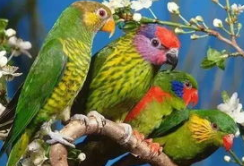- 阅读
- 阅读
- 技巧
- 百科
- 试题
- 文化
- 技能
This is Scientific American’s Science, Quickly. I’m Karen Hopkin.
这里是《科学美国人》的科学快报。我是凯伦·霍普金。

Keeping these experimental vocalizations to a whisper makes sense if you want to avoid attracting predators to your nest.
如果想要避免吸引捕食者靠近鸟巢,把这些实验叫声保持在低语状态。
And South American parrots are not the only ones that do it.
南美鹦鹉(绿腰鹦哥)并不是唯一会这么叫的鹦鹉。
Berg has since found that the babies of another type of parrot, one that lives in Mexico and southern Texas, also babble—in work he’ll be presenting at the Animal Behavior Society’s annual meeting this summer.
此后,伯格发现了一种生活在墨西哥和德克萨斯州南部的鹦鹉,这种鹦鹉的幼崽也会咿咿呀呀,他将在今夏的“动物行为学会”的年会上展示他的研究成果。
Now, as to what all this babbling is about, Berg says it’s not likely a form of social communication, because the birds often do it when no one else is listening.
现在,至于这些咿咿呀呀的叫声是怎么回事,伯格认为这不太可能是一种社会交流形式,因为这种鹦鹉在无人倾听时也常常会这么叫。
A better explanation for what they’re doing is: they’re practicing and possibly adjusting the way they make certain calls as they get a better handle on what they’re hearing, presumably by watching and listening to adults as they interact.
对这一行为的更好的一种解释是: 鹦鹉幼崽正在练习、可能在调整发出某种叫声的方式,因为它们能更好地掌握听到的声音,大概是互动时通过观察与倾听成年鹦鹉的叫声学习的。
So, in addition to producing the standard “feed me” chirps, the babies are tossing out contact calls like the ones adults use to coordinate their movements, alarm calls like the ones that ring out when a parrot spots a snake or a hawk and warbling calls that are produced to defend the nest.
除了会发出标准的“喂我”的吱吱声外,鹦鹉幼崽还会发出表示联系的叫声,比如,成年鹦鹉用这种声音来协调行动,还会发出警报声,比如,鹦鹉发现蛇或鹰时会发出这种声音,还会发出为保护巢穴而产生的鸣叫声。
But in babbling, all these calls are just sort of jumbled together without any readily identifiable purpose or context.
但咿呀学语时的所有叫声都混杂在一起,无法轻松识别这些声音的用意和语境。
It’s like a rehearsal for when the birds really do have nests to defend, behaviors to coordinate and predators to warn about.
当鹦鹉幼崽真的有巢穴要保卫、有行动要协调、有捕食者要警告时,这就像一场排演。
So babbling is a medley, a tossed salad of all these different calls that either are already or will eventually be used in more specific functional contexts.
叽喳乱叫是所有不同叫声的集成曲、混合声,这些叫声要么在特定的功能性语境中已经使用,要么最终会使用。
Berg also found that a babbling parrot’s playlist can be boosted by steroids.
伯格还发现,类固醇可以增加咿呀学语鹦鹉的歌曲播放列表。
By giving a modest dose of corticosterone to nestlings twice a day for a week, we were able to show that the corticosterone-treated nestlings had a larger repertoire.
通过让鹦鹉幼崽摄入适量的皮质酮,每日两次,持续一周,我们能够证明,接受皮质酮处理的幼鸟掌握了更广的曲目。
That makes sense because stress hormones are key to coordinating a baby bird’s growth and maturation.
这合情合理,因为应激激素(皮质酮)是协调幼鸟成长与成熟的关键。
Now, as to whether having a more extensive songbook might be beneficial ...
现在,关于拥有大量的曲集是否有益……
It’s quite possible. A large repertoire in songbirds has been shown to be advantageous in numerous ways related to reproduction.
很有可能。鸣禽的多样曲目已被证明在与繁殖相关的许多方面有益。
To find out if the same is true for parrots, Berg will continue to observe his oldest feathered friends.
为了弄清鹦鹉是否也是如此,伯格将继续观察那些长着羽毛的老朋友。
One way we can figure that out is by continuing the long-term ecological monitoring, where we capture essentially every individual in the population and put unique color bands on them.
我们可以弄清楚的一种方法是,继续进行长期的生态监测,我们捕捉种群中的每个个体,并在其身上粘贴独特的彩带。
That way Berg and his colleagues can assess whether the parrots who had the widest vocabulary in their baby days ...are the movers and shakers in parrotlet society today ...
通过这种方式,伯格与同事们可以评估那些在幼崽时期词汇量最大的鹦鹉是否……成为了今天鹦鹉界的大佬…...
At least as evidenced by their reproductive success, which would be something to crow about.
至少在繁殖成功这方面证明了这一点,这是值得夸耀的。
Science, Quickly is produced by Jeffery DelViscio, Tulika Bose and Kelso Harper.
科学快报由杰弗里·德尔维西奥、图利卡·博斯和凯尔索·哈珀制作。
Subscribe wherever you get your podcasts and visit ScientificAmerican.com for updated and in-depth science news.
订阅播客,访问ScientificAmerican.com获取最新、深入的科学新闻。
For Scientific American’s Science, Quickly, I’m Karen Hopkin.
这里是《科学美国人》的科学快报,我是凯伦·霍普金。
来源:Scientific American
参与评论